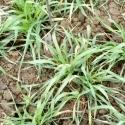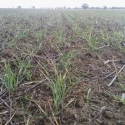07 Aug 2015
Supplying sulfur in cropping systems
Rob Norton & Elaina VanderMark
 Sulfur deficiency in canola
Sulfur deficiency in canola
Sulfur in Plants
Soluble sulfate (SO42-) is the primary source of S nutrition for plants provided by the soil. S can also be absorbed through the leaves from the air as sulfur dioxide (SO2), however this only occurs at levels high enough to contribute to the S status of the plant in industrial areas and therefore does not play a significant role in Australian agriculture. Within the plant, S performs many functions, the most important being energy and protein production. S is a constituent of three of the 21 essential amino acids that form proteins. This function is of particular importance for wheat as low grain sulphur means poor baking quality – due to a lack of the S-containing amino acids. S is also essential for N fixation by legumes.
Since both S and N are needed for protein formation, these two nutrients are closely linked. Crops have varied requirements for S compared with N, and have a wide N:S ratio in the harvested product (Table 1). For example wheat has a relatively low requirement of S, with an N:S ratio in grain of 16:1. Canola however has a much high S requirement, with a N:S ratio of 6:1 in the seed. Canola, grain legume crops and high yielding forages generally have a higher demand for S than cereal crops.
Table 1. Total removal of sulfur in the harvested portion of selected field crops compared to N, P2O5 and K.
| Crop | Yield (t/ha) | N (kg/ha) | P (kg/ha) | K (kg/ha) | S (kg/ha) | N:S ratio |
| Corn | 13 | 134 | 31 | 41 | 16 | 8:01 |
| Soybeans | 4 | 195* | 19 | 59 | 11 | 18:01 |
| Wheat | 4 | 89 | 15 | 16 | 6 | 16:01 |
| Lucerne | 12 | 255* | 26 | 201 | 27 | 9:01 |
| Canola | 3 | 120 | 18 | 16 | 13 | 6:01 |
Sulfur in Soils
The majority of S in soil is found in organic matter and crop residues and is unavailable for plant uptake. Before S can be absorbed it needs to be converted to its soil soluble form, sulfate (SO42-).
Sulfate is generally soluble and readily moves with soil water to roots, or can be subject to leaching below the root zone in areas with high rainfall or with excessive irrigation. It is only weakly retained (adsorbed) by a variety of clays and soil minerals, especially in low-pH conditions. Because sulfate is mobile, it can accumulate at depths, so soil sampling to the full root depth is often important to ensure that deeper S is included in any nutrient budget. Often, the inclusion of deeper layers will improve the predictability of soil S tests, particularly on lighter soils.
High S levels in soils can reduce the uptake of molybdenum as well as selenium, mainly because these two nutrients compete for the same transporters in the roots. Selenium, while not essential for plants it is required by animals to prevent muscular dystrophy. Sulfur fertilization can also reduce the uptake of boron, while acidification in the zone of application can stimulate the uptake of micronutrients like copper and manganese.
Sulfur Deficiency
S deficiency symptoms include small and pale green colour in the younger leaves (see pictures). This is because S is relatively immobile in plant tissue and so does not move again. In canola, plants may also suffer from thin stems and leaves may develop a reddish colour first apparent on the underside of the leaves. In canola, the flowers may also be visibly affected. They can be pale in colour and in severe cases can appear almost grey.
S deficiency is an increasing problem in parts of the world especially where higher yielding crops have been developed and introduced. High yielding crops absorb more S from the soil leading to high S removal when the crop is harvested. There has also been a shift away from the use of fertilizers that contain S, such as superphosphate, towards fertilizers that are high in other nutrients, such a MAP and DAP, but that contain little or no S.
Conservation tillage is another practice that has the potential to lock up S in the soil and induce deficiency. Sulfur is taken up by the plant from the soil as the crop grows but is tied up in the crop residue at the soil surface after harvest. Although the total S content in the organic matter may be high, without cultivation of the soil, the breakdown of organic matter to release nutrients such as S is reduced and the crop is more likely to require S fertilizer application to avoid deficiency occurring.
The extent of S deficiency across Australia is unknown. Low soil test values are becoming more common across many soils, but S deficiency is mainly seen on lighter soils in better years rather than every season.
Soil tests for S response.
The KCl-40 soil test was developed in Australia to estimate where soils would respond to additional S. This was first used in pastures, but its use now is common in cropping systems. The recent Better Fertilizer Decisions for Crops project reviewed the data on critical values for this test, and found that deeper soil tests generally gave a more reliable result. Overall though the interpretation is still difficult as there were very few experiments in southern Australia. Table 2 gives some generally accepted values, although the crop are based largely on Western Australian experiments.
Table 2: KCl-40 soil test interpretative values, based on Anderson et al. 2013.
| Crop | Sample depth | Deficient | Marginal | Adequate |
| Pasture | 0-10 cm | <5 | 5-10 | >10 |
| Canola | 0-10 cm or 0-30 cm | <6 | 6-8 | >8 |
| Wheat | 0-10 cm | <3 | 3-6 | >6 |
0-30 cm (WA) | <4 | 4-5 | >5 |
Most testing services offer a S analysis for deep (0-60 cm) soil tests, and this can be used as a basis for budgeting S based in demand and supply, in the same way that mineral N is budgeted. Taking account of deep S – such as in gypsum layers – can improve the interpretation of these results.
Plant tissue tests are also available, and the critical values depend on the tissue taken and time of sampling as well as the amount of root growth. For the youngest expanded leaf in wheat, the critical value is around 0.3% at the start of stem elongation. The critical value for canola (whole shoots) is around 0.6% at rosette and declines as the plant ages.
Sulfur sources
There are numerous sources of S fertilizer available for use, some containing soluble sulfate that provides immediately plant available S, and others that contain insoluble elemental S that requires a conversion to sulfate before the plant can access the additional nutrients.
Elemental Sulfur (99% S): Elemental sulfur is insoluble and requires microbial oxidation to sulfate before plants can take it up. Much of this oxidation is governed by the properties of the elemental sulfur and the soil environmental conditions. Very small particles are oxidized more rapidly than large particles but they are difficult to uniformly apply to the soil and air-borne sulfur dust can present a fire and explosive hazard, making it impractical as a common fertilizer. This source is best mixed with the soil rather than banded.
Clay-amended sulfur (90% S): Molten sulfur is mixed with approximately 10% bentonite clay to form an expanding pellet. When the bentonite clay becomes wet in the soil, it swells and the elemental sulfur breaks into many small pieces with a very large reactive surface area. Many of these products are made as pastilles and amended with various micronutrients (including Zn, Fe, and Mn) that may benefit from the acidity produced during sulfur oxidation.
Gypsum (16 to 18% S): Calcium sulfate (CaSO4.2H2O) is only slightly soluble in water (0.2 g/L) and provides some sulfate for plant nutrition as it dissolves. Additionally, gypsum is used as a calcium source in the reclamation of sodic soils. Gypsum quality can vary so ensure if this source is used that it meets the minimum standards.
Single Superphosphate (11 to 12% S): One of the first commercially available fertilizers, single superphosphate is formed by reacting sulfuric acid with rock phosphate to produce a mixture of monocalcium phosphate and gypsum. The popularity of this fertilizer has declined because more concentrated forms of phosphorus fertilizers reduce transportation and handling expenses.
Ammonium sulfate (24% S): Ammonium sulfate is commonly used in the fertilizer industry to supply both nitrogen and sulfur. Most of this fertilizer comes as a by-product from various industrial processes, although it is sometimes made by the reaction of ammonia and sulfuric acid. Ammonium sulfate is very soluble and is also used in fluid fertilizers.
The soil acidification that occurs following application of ammonium sulfate arises during the nitrification of ammonium (to nitric acid), rather than from the sulfate that is applied.
Potassium Sulfate (17 to 18 % S): This common fertilizer can be recovered directly from saltwater brines or produced by reaction of various minerals and acids. It is very soluble and makes an excellent source of sulfate for plants. Potassium sulfate is often used in conditions where it is desirable to minimize chloride in the soil (such as from the use of KCl) or to maintain a lower salt content than some other fertilizers.
Potassium Magnesium Sulfate (Langbeinite) (22% S): Langbeinite is mined from geologic sources and provides a soluble source of three plant nutrients. Kieserite (Magnesium sulfate) is another mined sulfur source that is also used to supply Magnesium. Both minerals are very soluble but neither are suitable for foliar use unless further processed. They can be used in their granular form applied to the soil.
Sulfur-enriched fertilizer: Common fertilizers (such as monoammonium or diammonium phosphate) are sometimes amended with small flakes of elemental sulfur and soluble sulfate to enhance the solubility of phosphorus and provide an extended release of sulfur. The acidity that develops surrounding the elemental sulfur can be beneficial in maintaining the solubility of nutrients such as phosphorus and zinc.
Thiosulfate (10 to 26% S): Thiosulfate fertilizers are clear liquids that contain sulfur in the form of S2O32-. They are highly soluble and mixed with other fluid fertilizers. In the soil, thiosulfate is converted to sulfate within a week or two in warm soils. Thiosulfates can have its attendant cation as ammonium, calcium, magnesium or potassium, which provide supplementary nutrients.
Manure and Compost: The sulfur content of manures and composts can be quite variable depending on the animal species, diet, and handling. On a dry weight basis, the sulfur content of manures and composts generally ranges between 0.3 and 1%. A period of mineralization is required to convert organic sulfur compounds to plant available sulfate prior to plant uptake.
Table 3: Sulfur content of some typical fertilizers.
| Product | N | P | K | S as SO42- | S as S0 |
| Superphosphate | 0 | 8.8 | 0 | 11 | - |
| MAP | 10.0 | 21.9 | 0 | 1.5 | * |
| DAP | 18.0 | 20.0 | 0 | 1.6 | - |
| Triple Superphosphate | 0 | 20.7 | 0 | 1.0 | - |
| Ammonium Sulfate | 20.2 | 0 | 0 | 24 | - |
| Gypsum | 10-16 | ||||
| Sulfur Bentonite | 0 | 0 | 0 | - | 90 |
| Potassium sulfate | 0 | 0 | 41 | 18 | - |
| Ammonium Thiosulphate | 12 | 26** | |||
| Langbenite | 17 | 21 |
Take care with in-furrow use of S fertilizers especially those formulated with N. Damage can occur particularly to canola. Options are to twin chute (to the side and below) or the use higher S rates on less susceptible crops to build S fertility. Alternatively, use gypsum (calcium sulfate dihydrate) is often used to ameliorate sodic soils and promote better soil structure. It also supplies S to the subsequent crops. Gypsum has a relatively low solubility, and rates of 500 kg/ha of gypsum (~60 kg S/ha) will require around 100 mm of rainfall to wash in and dissolve it and make the sulphur plant available.
Many crops recover well from mild nutrient stress, provided soil levels are adequate for early growth, so an alternative strategy is to top-dress sulfate S sources, preferably before the period of peak nutrient demand for the crop. Use reliable soil and tissue tests to evaluate the in-crop S status although sampling depth and subsequent S supply may result in topsoil or early season tissue tests indicating an incorrect potential response to further applied S.
Apply a source of S that has both sulfate and fine-particle sized elemental S. The sulfate-S portion is available immediately to the crop while the elemental S needs to be oxidized by soil microorganisms to supply sulfate-S for crop use. Some growers use a straight elemental form of S, but even if the product has been formulated with a high portion of small particle sized S, when it is placed in a seed-row, or in a side-band the oxidation rate of the elemental-S has been slow, up to 3 to 4 years under most conditions. By using a 50:50 mixed sulfate-S and fine particle sized elemental-S product, the sulfur needs of the crop can be better supplied. Examples of available sulfate and elemental S-containing products are compound fertilizers made up of layers of ammonium phosphate, ammonium sulfate and fine-sized elemental S.
Crop response to Sulfur
Crop response to S in Australia is generally minimal due to the long-term use of single superphosphate. Responses to S application are generally greater in light sandy soil, especially in crops with a high requirement for S such as canola. N and S demands are linked (Table 4) so attention to S may be needed with higher N rates. It is possible to prevent yield losses if S deficiency is diagnosed early in a growing season and is promptly top-dressed with a sulfate form of fertilizer. Attention to S fertilization is becoming more important, especially with the increase in conservation tillage and because higher yielding crops are taking up and removing more S from soil as harvested products.
Table 4: The yield of canola (t/ha) to N and S, mean of seven sites in Western Australia (Brennan and Bolland 2008). The least significant difference (p=0.05) is 0.12 t/ha.
| N applied
(kg N/ha) | S applied (kg S/ha) | |||
0 | 6 | 13 | 25 | |
| 0 | 1.06 | 1.28 | 1.34 | 1.01 |
| 35 | 1.07 | 1.39 | 1.54 | 1.36 |
| 69 | 1.06 | 1.47 | 1.66 | 1.68 |
| 138 | 1.07 | 1.50 | 1.68 | 1.68 |
Further reading
Norton, R., R. Mikkelsen, and T. Jensen. 2013. Better Crops 97 (2): 10-12.
Mikkelsen, R., and R. Norton. 2013. Better Crops 97 (2): 7-9
Hocking, P.J et al 1996. Australian Journal of Experimental Agriculture, 36, 79-85
Brennan and Bolland. 2008. Journal of Plant Nutrition, 31, 1174-1187.




